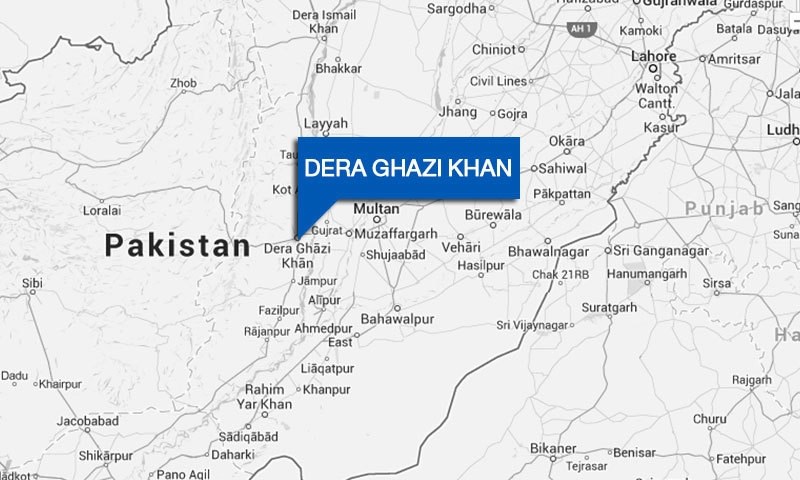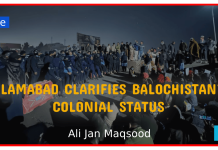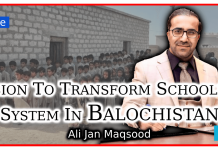As our government mulls over the questionable fate of the Seraiki province, protests have erupted all over the country with calls for all kinds of provinces – provinces based on ethnicities, provinces based on “administrative grounds”, provinces based on linguistic differences. So while there are calls to permanently damage Pakistan’s already-frayed map, here are my two cents on a concern Maula Fazalur Rehman raised at the meeting where the commission came up with recommendations for the new province.
A brief history of Dera Ghazi Khan is in order. The city goes back as far as 1476 when Baloch chieftain Nawab Ghazi Khan Mirani declared independence from the Langah Dynasty of Multan. Along with two other deras (encampments) – Dera Ismail Khan and Dera Fateh Khan – Derajat was born.
Derajat eventually came into the possession of the British rule after the Sikh War of 1849. It was then divided into two districts, Dera Ismail Khan and Dera Ghazi Khan. A little known fact about this division is that the tribal leaders were presented the option of going with Balochistan or Punjab. The Baloch leaders of DG Khan, under an agreement with the British rulers, chose to side with Punjab. While the exact terms of the agreement are not known, the general principles of the agreement were that the tribal leaders would be allowed to continue to uphold their Jirga traditions and largely remain separate from direct government intervention in their affairs. This is, of course, largely conjecture but a layman in DG Khan today would tell you the same story. There is also a widely held view that another agreement was signed at the time of the partition with similar conditions.
Naturally, both these agreements do not stand anymore. However, the Baloch presence in Southern Punjab is still there. The population of DG Khan today roughly comprises of 80 percent Baloch. This is largely due to the proximity of Balochistan to the city – Dera Ghazi Khan is nestled right at the tail of Suleiman Range that opens in Punjab. These are not the Seraiki speaking Baloch, as is the widely-held belief. Instead, Balochi is the commonly spoken language of the area. Another reason for the large number of the Baloch in the city is the presence of the Baloch tribal families and their landholdings surrounding the region.
So, if this new province is being created along ethnic lines, it is surprising that no one has taken into account the presence of the Baloch in the new Seraiki province. Who is going to speak for them? There has been no survey conducted to see if the people of Southern Punjab actually want the new province, let alone a referendum, giving a choice to the Baloch of the province to side with Balochistan if they so wanted.
Naturally, one would ask why DG Khan would want to go over to Balochistan. That province, after all, is in deep turmoil itself. There is little economic growth and development, poor law and order situation and a generally volatile ethnic balance.
It is precisely for this very reason that DG Khan going under the provincial control of Balochistan might just end up benefitting Balochistan and DG Khan.
While Balochistan is the largest province of Pakistan in terms of area, it is also the poorest. Balochistan has the lowest literacy rate among all of Pakistan’s provinces. According to National Economic Survey, the province also has the least number of educational institutions, the lowest literacy rate among both males and females, the lowest ranking in the Gender Parity Index (GPI) and the smallest presence of private educational institutes in the country. Furthermore, about six percent of the schools in Balochistan do not have buildings, nine percent lack electricity, 12 percent are devoid of clean drinking water and 11 percent are without proper latrine.
So now imagine a city, a relatively poor city of Punjab, entering Balochistan’s sphere. This city has a literacy rate of 60 percent – quite a feat for such a small, poor district. There are at least 15 different institutes in the city. There is a medical school, a college of agriculture, several law institutes, colleges of commerce and colleges of education. Furthermore, there are a number of public and private sector primary education institutes functioning in the area.
Similarly, the economy in Dera Ghazi Khan is relatively rich for such a small city. It is located in rich agricultural land with cotton, wheat, sugarcane, rice, tobacco being the major crops being grown. The city is also famous for its dates. Furthermore, the city has access to other parts of the country via railway, including Multan, Lahore, Karachi and Quetta.
One cannot, as well, forget the all-important DG Khan Cement Company Limited, Pakistan Atomic Energy Commission, the Al-Ghazi Tractors and Rahim Bux Textile Mills. A commonly held, if also commonly forgotten, belief is that these companies along with several other flour, cotton, chemical and rice mills in the area form the backbone of Punjab.
Balochistan, as a province, could do well with a city that boasts of educational and economic development. And DG Khan, similarly, could do well with Balochistan as its vital city, bustling with economic growth and educational strength (yes, I am hinting as DG Khan being the capital city of Balochistan). One must not forget that Balochistan also has a vast supply of natural gas, coal and other minerals. Other untapped aspects of Balochistan’s economy are fisheries, mining, manufacturing industries and trade. With a close proximity to Punjab via DG Khan, and with the benefits of DG Khan pouring in to Balochistan, the Baloch on either side of the Suleiman Range could do well together.
DG Khan also has a relatively balanced ethnic ratio. It is a safer and more stable city. Balochistan, as a province, needs a city like that under its sphere. And DG Khan, as a city, needs a stronger recognition and a presence in a province that would actually benefit from it.
So while our leaders mull and debate and while our intellectuals tweet and argue, the question remains, who will speak for the Baloch of DG Khan? What is their place in the new Seraiki province, when they, after all, not Seraiki?
The writer is a research analyst at Spearhead Research and tweets at @aimamk










